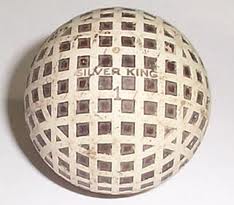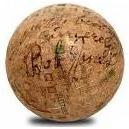Golf Ball History
 Historical
references of the first golf ball makers point to Holland back in the 15th century.
Dutch golf players originally played with wooden golf balls made from elm or beech.
Historical
references of the first golf ball makers point to Holland back in the 15th century.
Dutch golf players originally played with wooden golf balls made from elm or beech.
Gradually the Dutch replaced the wooden ball with a white leather ball filled with cow's hair which was used in the local game of kaatsen (hand tennis).
The kaatsen ball later inspired the Scots to invent the "feathery" sometime in the 17th or early 18th century as a replacement for the wooden ball that had little aerodynamic or control benefits.
See History of the golf ball below
 Spend
less on top brands by shopping through our discount golf ball stores directory. Plus, check
out our guides here to enjoy some humor on the golf course.
Spend
less on top brands by shopping through our discount golf ball stores directory. Plus, check
out our guides here to enjoy some humor on the golf course.
Antique Golf Balls For Sale
- Antique Feathrie Golf Balls For Sale
- Antique Bramble Golf Balls For Sale
- Antique Mesh Golf Balls For Sale
- Antique Gutta Golf Balls For Sale
- Antique Gutty Golf Balls For Sale
- General Search Antique Golf Balls
Historical Timeline Of Golf Ball Evolution
 During
the latter part of the first decade in the twentieth century, golf ball manufacturers were
experimenting with rubber core mesh balls. It was at the beginning of this period that the
modern day golf ball came to be.
During
the latter part of the first decade in the twentieth century, golf ball manufacturers were
experimenting with rubber core mesh balls. It was at the beginning of this period that the
modern day golf ball came to be.
Early dimple balls offered players greater spin and feel and competitors began designing unique mesh type patterns on golf balls.
 There
was the Rifled Ball with groves like in the barrel of a gun, raised banana shapes, donut
dimples, Stars, Circles, Hexagons and eventually the square mesh ball became standard.
There
was the Rifled Ball with groves like in the barrel of a gun, raised banana shapes, donut
dimples, Stars, Circles, Hexagons and eventually the square mesh ball became standard.
Golf Ball History
 In
the earliest days of golf on the eastern coast of Scotland, players used primitive equipment
to play the game. The first clubs and balls specifically made for golf were fashioned from
wood. The balls used were made from hardwoods such as beech that were likely imported from
Holland. These balls were used from the 14th to 17th Century .
In
the earliest days of golf on the eastern coast of Scotland, players used primitive equipment
to play the game. The first clubs and balls specifically made for golf were fashioned from
wood. The balls used were made from hardwoods such as beech that were likely imported from
Holland. These balls were used from the 14th to 17th Century .
Record books show that in 1447 King James II outlawed golf due to concerns that his subjects preferred playing golf over weapons training.
 The
Feather Ball: In 1618 the feather golf ball or 'Featherie' was created most likely with
inspiration from the Kaatsen Dutch hand ball. The feather ball period was the longest period
of stability in the history of the golf ball. The feathery ball period lasted from as early
as the 14th Century to as late as the 16th Century and was produced until the early 1850's.
Originally these balls were likely to have been filled with wool or hair. Ultimately the
contents were changed when it was discovered that the use of feathers would produce a livelier
and longer lasting ball golf ball that was preferred over the previous versions.
The
Feather Ball: In 1618 the feather golf ball or 'Featherie' was created most likely with
inspiration from the Kaatsen Dutch hand ball. The feather ball period was the longest period
of stability in the history of the golf ball. The feathery ball period lasted from as early
as the 14th Century to as late as the 16th Century and was produced until the early 1850's.
Originally these balls were likely to have been filled with wool or hair. Ultimately the
contents were changed when it was discovered that the use of feathers would produce a livelier
and longer lasting ball golf ball that was preferred over the previous versions.
Feather Ball Construction: Several pieces of stout leather were tightly stitched, leaving a small opening. Boiled and softened feathers were tediously stuffed into the casing before the final stitches were made. The surprisingly hard feather ball was hammered into roundness and coated with several layers of paint.
 The
Gutty Ball: This is where the modern era started, with the feathery being replaced by the
gutty. Gutty-percha is a similar material to rubber that is made from the dried sap of a
tree. The first "Gutta" ball is believed to have been made in 1848 by the Rev. Dr. Paterson
from gutta-percha packing material. Gutta-percha is the evaporated milky juice or latex
produced from a tree most commonly found in Malaysia. Gutta balls, were handmade by rolling
the softened material on a board. The new durability of the Gutta, together with its much
lower cost, resistance to water, and improved run, provided rejuvenation to the game of
golf, thus the Gutta gradually replaced the Feathery.
The
Gutty Ball: This is where the modern era started, with the feathery being replaced by the
gutty. Gutty-percha is a similar material to rubber that is made from the dried sap of a
tree. The first "Gutta" ball is believed to have been made in 1848 by the Rev. Dr. Paterson
from gutta-percha packing material. Gutta-percha is the evaporated milky juice or latex
produced from a tree most commonly found in Malaysia. Gutta balls, were handmade by rolling
the softened material on a board. The new durability of the Gutta, together with its much
lower cost, resistance to water, and improved run, provided rejuvenation to the game of
golf, thus the Gutta gradually replaced the Feathery.
 Hammered
Gutta-percha enormously enhanced the game of golf, and it was soon discovered by golfers
who failed to smooth their balls by boiling and rolling them on a "smoothing board" after
play, that a many "nicked" balls had truer flight than the smooth gutta. Thus the hand hammered
gutta was created by hammering the softened ball with a hammer to give the ball an even
pattern that greatly improved its play. Later iron molds or ball presses were used to form
the balls and create patterns.
Hammered
Gutta-percha enormously enhanced the game of golf, and it was soon discovered by golfers
who failed to smooth their balls by boiling and rolling them on a "smoothing board" after
play, that a many "nicked" balls had truer flight than the smooth gutta. Thus the hand hammered
gutta was created by hammering the softened ball with a hammer to give the ball an even
pattern that greatly improved its play. Later iron molds or ball presses were used to form
the balls and create patterns.
 Bramble
Surface textures and patterns impressed into the gutta-percha balls evolved to greatly improve
the ball’s flight. The best known balls were the hand-marked private brands of the Scottish
club makers. Many brands with a variety of patent names used the bramble pattern (with a
surface similar to the berry). This became the most popular pattern of the gutta era and
was also used on some of the early rubber balls.
Bramble
Surface textures and patterns impressed into the gutta-percha balls evolved to greatly improve
the ball’s flight. The best known balls were the hand-marked private brands of the Scottish
club makers. Many brands with a variety of patent names used the bramble pattern (with a
surface similar to the berry). This became the most popular pattern of the gutta era and
was also used on some of the early rubber balls.
 The
rubber ball was invented in 1898 by a Cleveland, Ohio, golfer, Coburn Haskell, in association
with the B. F. Goodrich Company. The ball featured rubber thread wound around a solid rubber
core. The Balata cover was developed in the early 1900’s. Bramble, mesh, reverse mesh, and
a great many other patterns gradually gave way to the aerodynamically superior dimple pattern
first used in 1908.
The
rubber ball was invented in 1898 by a Cleveland, Ohio, golfer, Coburn Haskell, in association
with the B. F. Goodrich Company. The ball featured rubber thread wound around a solid rubber
core. The Balata cover was developed in the early 1900’s. Bramble, mesh, reverse mesh, and
a great many other patterns gradually gave way to the aerodynamically superior dimple pattern
first used in 1908.
 Modern
On January 1, 1932, standardization of golf ball weight and size was established by the
United States Golf Assn. following 1930 standards set by the British Golf Assn. for a slightly
smaller ball. The weight was set at a maximum of 1.620 oz., and diameter not to be less
than 1.680 in. Later. after testing apparatus was developed to measure velocity, a maximum
velocity of 250 feet per second was added by the USGA. The durability and precision of today’s
balls reflect technological advancement of their manufacture and the development of space
age plastics, silicone, and improved rubber.
Modern
On January 1, 1932, standardization of golf ball weight and size was established by the
United States Golf Assn. following 1930 standards set by the British Golf Assn. for a slightly
smaller ball. The weight was set at a maximum of 1.620 oz., and diameter not to be less
than 1.680 in. Later. after testing apparatus was developed to measure velocity, a maximum
velocity of 250 feet per second was added by the USGA. The durability and precision of today’s
balls reflect technological advancement of their manufacture and the development of space
age plastics, silicone, and improved rubber.
